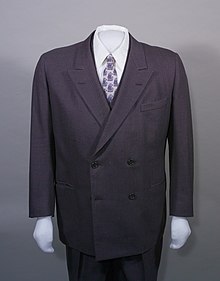what synthetic material is similar to shark skin

Contemporary sharkskin "shiny suit"
Sharkskin is a generic term used to draw a woven or warp-knitted fabric that imitates a shark'south pare. The lines run from lower left to upper right on the face of the material . Sharkskin cloth in woven category varies with plainly, basket and twill weave formations, It is typically made with acetate and rayon yarns, also as with worsted wool and diverse synthetic blends. The combination of color of the yarns and twill weaving pattern in which the colored threads run diagonal to the white yarns, results in the cease for which sharkskin fabric is known. It has smooth but crisp texture and ii tone lustrous appearance. Lightweight and contraction-complimentary, sharkskin is platonic for curtains, tablecloths and napkins. Sharkskin fabric is popular for both men's and women's worsted suits, light wintertime jackets and coats. Sharkskin is ordinarily used as a liner in diving suits and wetsuits.[ane] [2] [3]
Composition [edit]

Sharkskin has historically been made with different types of natural fibers, including either mohair, wool and silk.
More expensive variations, often demarcated past cloth content labels begetting "Golden Fleece", "Regal" or the like, indicate an extremely rare and costly "sharkskin" of yester-yr. Those fabrics, produced in minor quantities, were manufactured in South America (Republic of peru and Argentina: past transplanted German/Italian weavers) from the 1950s and 60s and are known to include in some instances fifty-fifty small-scale percentages of vicuna, guanaco or alpaca in such blends: inclusion of silk (so a very plush cobweb) was even more common amidst the "natural sharkskin". Whereas, "artificial sharkskin", a much less costly substitute, is a cloth variant that is more often found from that catamenia and tin can contain synthesized or constructed fibers that were developed gimmicky to those eras.[4]
Bogus variations [edit]
Artificial sharkskin variants used for suiting starting time appeared in the 1950s and rapidly garnered worldwide appeal in artificial sharkskin (costing much less than its "natural" counterpart: which most consumers were non aware existed, so far out of their toll range it remained), attaining broad popularity in the early 1960s and the disco era of the late 70s, followed by cursory style resurgences in the mid-1980s, mid-1990s and tardily 2000s: its variations often comprise some wool percentage alloy. More than recently, such artificial sharkskin fabrics have undergone technological improvements and accept attained new desirability, fifty-fifty among "fabric purists" who would accept conventionally rejected out-of-mitt any "artificial sharkskin" substitutes for the existent particular containing a majority pct of mohair.
The term "Super-Sharkskin" has been used to depict relatively plush sharkskin fabrics which include some percentage of synthetic fibers.[ commendation needed ] The add-on of synthetics can create a heightened metal-similar sheen, and/or added flexibility (as with a 2% Lycra blend).
Fashionability [edit]
Many attribute the "fading in and out of style" of sharkskin of any sort to the fact that many of the ubiquitous "artificial sharkskin" variants had "created an indelible public impression that all sharkskin ought to be deemed "tacky", to be eschewed, as it is in Lisa Birnbach'south Official Preppy Handbook, 1980, which reflected, and in itself, in turn, influenced, many consumers' misgivings regarding its social condition. From the late 2000s until the mid 2010s, three piece sharkskin "shiny suits", sometimes incorporating a contrasting shawl collar, briefly became fashionable in America and Australia due to a resurgence of interest in the early 1960s fashions depicted in Mad Men.[5] [6] [seven]
Importantly, whether "natural" or "artificial", today the line betwixt the two has been blurred by the accelerate of innovative blends. Even so, "natural sharkskin" from the 1950s and 1960s men'south and women's suits remain highly sought in the vintage clothing market, commanding extraordinary prices online. The most desired sharkskin colors feature a peacock iridescent palette.
Middle East [edit]
British Diplomat Sir Terence Clark in the 1950s served in Bahrain. He reminisces that the requisite winter evening wear for a diplomat was a white sharkskin dinner jacket.[eight] Lucette Lagnado in her prize-winning memoir about her babyhood, The Man in the White Sharkskin Suit: My Family's Exodus from Erstwhile Cairo to the New World uses the imagery of the white sharkskin suit to evoke the glamorous evening life in Egypt in the 1950s. Early in Justine, Lawrence Durrell mentions the heroine sitting in forepart of a multi-console mirror trying out a sharkskin dress; the book is set in the high society of diplomats and businessmen in Alexandria in the 1930s, a city where Durrell spent much fourth dimension during Globe War II, a few years later.
See as well [edit]
- Shot silk
References [edit]
- ^ The Textile Found and Industry - Volume 5. The University of Michigan: Cloth Constitute. 1967. p. 174.
- ^ Frank Pollatsek, William Seitz, Louis Goldblatt (1952). Fabrics Today and Drycleaning - Book 1. Origin University of Minnesota: New York Neighborhood Cleaners Association. p. 36.
- ^ Tregonning, Melwyn. Fabric Dictionary. Mel Tregonning.
- ^ Harris, Milton (1962). Natural and Synthetic Fibers Yearbook. p. 156.
- ^ Shiny suit rules
- ^ Suit problems for men
- ^ Boston style guide
- ^ Churchill College Cambridge. "British Diplomatic Oral History Plan (BDOHP)". Archived interview: Quondam member of the British Diplomatic service Charles Cullimore interviews fellow diplomat Sir Terence Clark on Fri 8, November 2002. Retrieved June eight, 2011.
Source: https://en.wikipedia.org/wiki/Sharkskin
Publicar un comentario for "what synthetic material is similar to shark skin"